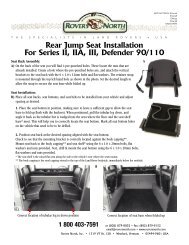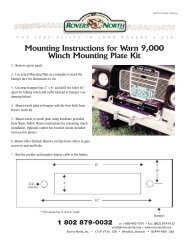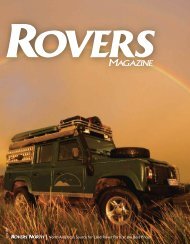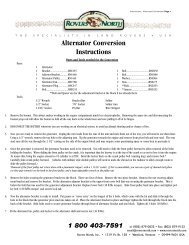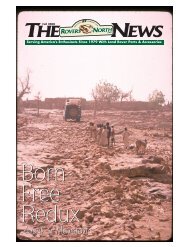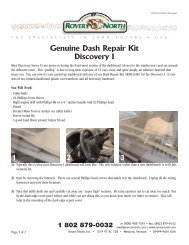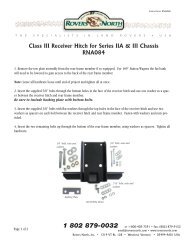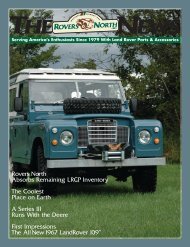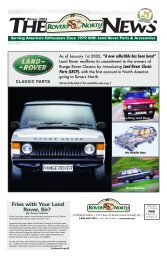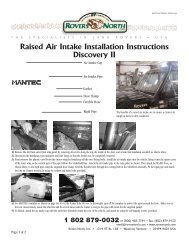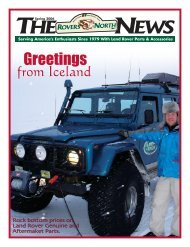You also want an ePaper? Increase the reach of your titles
YUMPU automatically turns print PDFs into web optimized ePapers that Google loves.
Trek to The T rains[Mike Smith, Warren, ME, embodies Land<strong>Rover</strong>s professionally and personally - profes -sionally as the head of East Coast <strong>Rover</strong>, andpersonally as the owner of a much-modified‘94 Defender 90 SW. He took the opportunityto enjoy his Defender in this expedition to thefar north of New England -ed.]If you live outside New England and you thinkof “winter,” you probably conjure up visions ofskiing, sleigh rides and similar picturesque set -tings. If you live in New England and you thinkof winters, you remember things like slush inyour boots, road salt eating your <strong>Rover</strong> and thenumber of times you’ve had to scrape the freezingrain off your windscreen in one day. Toomany Land <strong>Rover</strong> owners wait until winter haspassed by to go off road, but given New Englandweather, if you wait for summer to go off road -ing, you’ll waste more than half your life!Winter is a great time of year for four-wheeling.It means that you and your <strong>Rover</strong> have to bea little better prepared to handle the added complicationsthat Mother Nature can throw at you,but it really is a blast. Last February a group ofenthusiasts set out to find the abandoned trackageand a pair of antique steam locomotivesreputedly sitting in the woods of NorthernMaine.Only through hearsay and tall tales had wecome to know of these locomotives in the middleof the Maine woods. What could two vintagesteam locomotives be doing 100 miles from thenearest usable railroad tracks? The historybehind the railroad fascinated us. The areaaround Eagle Lake - indeed all of Northern NewEngland - has been extensively logged for 200years. Before trucks hauled the timber out, logdrives floated timber down the rivers to the millsof central Maine. The problem is that not all therivers flow south or east towards these establishedmills; about half flow north towardsCanada. Timber companies needed a practicalway to get the timber over the land to the correctwaterway and down to the mills. In the mid-19th century canals with lock systems weretried, but these proved slow and troublesome. Inthe early 1900’s a rail-based tramway was builtacross the 3000 foot stretch of land that dividedEagle Lake and Chamberlain Lake. The tramwayconsisted of train style axles attached to a cable,driven by steam engine and large sprockets.Logs rested on the axles, then dumped into thewater for the trip downstream. This worked wellfrom 1903-1909, until the timber harvest wascompleted.The use of steam engines and railway hadmade their mark. When the huge new mills ofMillinocket, Maine, needed timber for paperproduction, Edouard Lacroix, a Canadian indus -trialist, set about building a rail line exclusivelyfor timber. In 1926, his company began laying arailroad from Eagle Lake, near the old tramway,Steam powered“Lombard” log hauler .west across Allagash Stream, down the shores ofChamberlain Lake to the head waters ofUmbazooksus Lake. The 13-mile railroad createda swath through the forest. Once the lakeshad frozen over, steam-powered Lombard loghaulers carried all the materials, includingenough steel for a 1500 foot bridge across theAllagash, to complete the project. These massivesteam powered snowmobiles brought in all thematerials over the ice for the railroad, includingthe switching engines and two steam locomo -tives, weighing over 90 tons each. The two locomotives,steam engines purchased from theRutland [VT] Railroad and the New YorkCentral, were converted to run on oil.The new railroad, first named the U&EL(Umbazooksus and Eagle Lake Line)became better known as the Eagle Lakeand West Branch Railroad. The railroadoperated for over four seasonsuntil the supply of timber was onceagain exhausted from the area. In 1930the engines were backed into therepair shed that housed them and theirboilers were shut down for the lasttime. And yes, we wanted to find theseabandoned engines.For a winter expedition, we checkeditems like snow chains and installed acomputer based GPS system into myDefender. Luckily, my traveling companion,Geoff Cox, just happens to havea PhD in this field and fitted the D90with a state-of-theartsystem thatbasically put ouractual positionwithin a meter. We would bejoined by Jason Tyler in hismuch-modified Range <strong>Rover</strong>Classic, and Ian Cooke in hisSeries II-A 88” coil sprunghybrid.We left the coast of Maineearly in the morning to get agood deal driving completedduring the day so as to be ableto set up camp that evening inthe daylight. Our trip took usthrough the middle of Maine, onmostly back roads from coastalWarren to Greenville, on the southern shores ofMoosehead Lake, a famous summer sportingregion. Moosehead Lake is also home to the oldpassenger vessel “Katahdin”. In the summermonths the vessel operates passenger tours ofThoreau’s favorite lake, but at this time of theIt’s true - we do have Moose in Maine!year the ship sits solidly encased in ice. In thewinter, Greenville becomes a snowmobilers paradise,and our plans to take trucks north ofEagle Lake in February received more than fewdoubting laughs by the snowmobile riders wemet at the Greenville gas station.From there, we began a long trip on dirt andgravel roads used solely for logging operations.You never quite know the conditions of theseprivate roads and you won’t find gas stations orstores for hundreds of miles until you near theCanadian border. This meant extra fuel for the<strong>Rover</strong>s had to be carried on board just to makeit in and out.We headed northeast out of town and out ofcivilization towards the settlement of Kokadjo,and then on to Eagle Lake. As the crow flies theGPS told us we only had about 70 miles to gountil we reached Eagle Lake, but even the bestoutfitted <strong>Rover</strong> can’t drive as the crow flies inNorthern Maine, so that meant we’d drain ourfull fuel tanks and our spare gas cans before wereturned to Greenville. For those of you whoknow the range of a Defender 90s that meansupwards of 300 miles before we’d see a townagain. After Kokadjo the roads become narrowerand narrower until you reach the “GoldenRoad.” The “Golden Road” is a year-round dirtroad that crosses the state of Maine from theeast to the town of Millinocket, a river townthat’s the home of two huge paper mills.Outside Kokadjo theviews became breathtaking. At a crest in theroad Big Spencer Mountain loomed in the distance.A few weeks before, we had completed ascouting trip to the logging roads aboveGreenville, Maine to recon our route. However,the eastern route around Moosehead Lake had© 2001 <strong>Rover</strong>s North Inc • 1319 VT Route 128, Westford, Vermont 05494-9601, USA • 802.879.0032 • e-mail rovers@together.net • www. r o v e r s n o r t h . c o m



